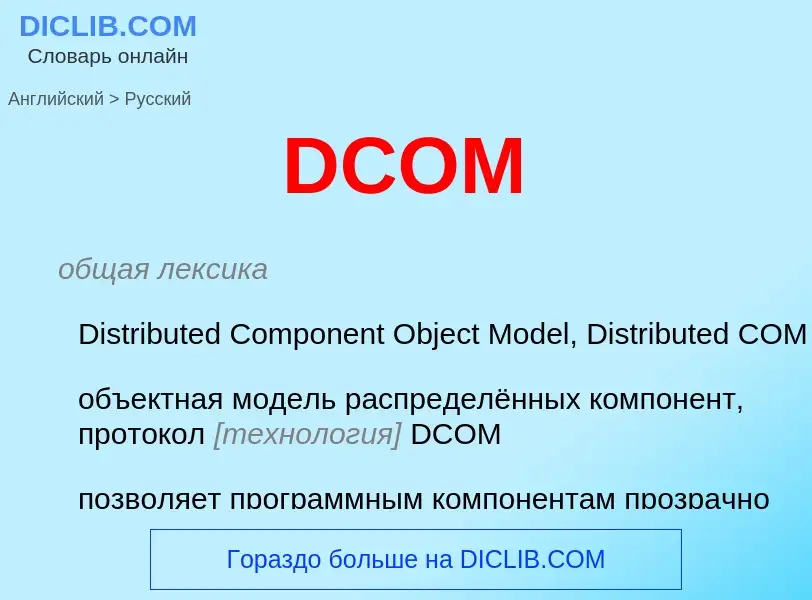Vertaling en analyse van woorden door kunstmatige intelligentie ChatGPT
Op deze pagina kunt u een gedetailleerde analyse krijgen van een woord of zin, geproduceerd met behulp van de beste kunstmatige intelligentietechnologie tot nu toe:
- hoe het woord wordt gebruikt
- gebruiksfrequentie
- het wordt vaker gebruikt in mondelinge of schriftelijke toespraken
- opties voor woordvertaling
- Gebruiksvoorbeelden (meerdere zinnen met vertaling)
- etymologie
DCOM - vertaling naar Engels
общая лексика
Distributed Component Object Model, Distributed COM
объектная модель распределённых компонент, протокол [технология] DCOM
позволяет программным компонентам прозрачно взаимодействовать между собой напрямую через сеть. Прежнее название - Network OLE. Разработан корпорацией Microsoft для Windows NT 4.0, базируется на RPC
['dʒʌmp'in]
общая лексика
быстро вскочить, впрыгнуть
фразовый глагол
общая лексика
вскочить
прыгнуть в воду
Wikipedia
Distributed Component Object Model (DCOM) is a proprietary Microsoft technology for communication between software components on networked computers. DCOM, which originally was called "Network OLE", extends Microsoft's COM, and provides the communication substrate under Microsoft's COM+ application server infrastructure.
The extension COM into Distributed COM was due to extensive use of DCE/RPC (Distributed Computing Environment/Remote Procedure Calls) – more specifically Microsoft's enhanced version, known as MSRPC.
In terms of the extensions it added to COM, DCOM had to solve the problems of:
- Marshalling – serializing and deserializing the arguments and return values of method calls "over the wire".
- Distributed garbage collection – ensuring that references held by clients of interfaces are released when, for example, the client process crashed, or the network connection was lost.
- Combining significant numbers of objects in the client's browser into a single transmission in order to minimize bandwidth utilization.
One of the key factors in solving these problems is the use of DCE/RPC as the underlying RPC mechanism behind DCOM. DCE/RPC has strictly defined rules regarding marshalling and who is responsible for freeing memory.
DCOM was a major competitor to CORBA. Proponents of both of these technologies saw them as one day becoming the model for code and service-reuse over the Internet. However, the difficulties involved in getting either of these technologies to work over Internet firewalls, and on unknown and insecure machines, meant that normal HTTP requests in combination with web browsers won out over both of them. Microsoft, at one point, attempted to remediate these shortcomings by adding an extra http transport to DCE/RPC called ncacn_http (Network Computing Architecture connection-oriented protocol).
DCOM was publicly launched as a beta for Windows 95 September 18, 1996.
DCOM is supported natively in all versions of Windows starting from Windows 95, and all versions of Windows Server since Windows NT 4.0

